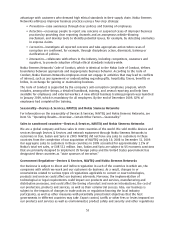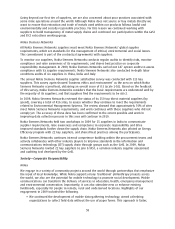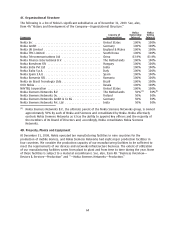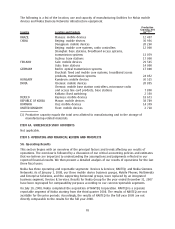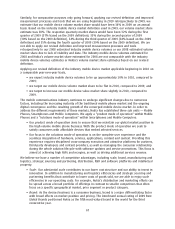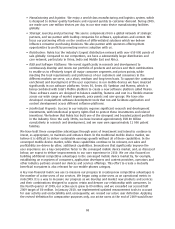Nokia 2009 Annual Report Download - page 62
Download and view the complete annual report
Please find page 62 of the 2009 Nokia annual report below. You can navigate through the pages in the report by either clicking on the pages listed below, or by using the keyword search tool below to find specific information within the annual report.In 2009, we continued to look for possibilities to reduce the environmental impact of our devices and
operations at each stage of the product life cycle. Focus areas include materials used, energy
efficiency, take back of used products, and eco services for our phones to help people to make
sustainable choices and consider the environment in their everyday lives.
Our environmental work is based on global principles and standards. Our targets are not driven solely
by regulatory compliance but are designed to go beyond legal requirements. Environmental issues are
fully integrated in our business activities and are everyone’s responsibility at Nokia.
Nokia’s climate strategy
Nokia’s climate strategy includes specific targets covering areas that contribute to our direct and
indirect carbon dioxide, or CO2, emissions. In 2009, the four main areas continued to be:
• Nokia products and services
• Nokia operations
• Nokia facilities
• Leveraging mobile and virtual tools in the way of working and management practices
There is also evidence that information and communications technology (ICT) can help reduce the use
of energy, thus slowing down global warming. ICTbased services and working methods such as
remote work and videoconferencing can result in lower overall CO2 emissions. Also, environmental
gains of dematerialization can also be significant. Convergence, or incorporating the functionalities of
several products into one product, can further contribute to dematerialization and energy efficiency.
In 2009, we continued to collect and communicate cases where mobile technology enables reductions
of energy consumption and CO2 emissions.
Since January 2008, Nokia has been a member of WWF’s Climate Savers, a program where WWF, or
World Wildlife Fund, and businesses collaborate to address climate change. Being a member of this
program reinforces our commitment to energy saving in our operations, ways of working and
products.
In 2009, Nokia joined the United Nations Global Compact’s Caring for Climate initiative, and
participated in Earth Hour globally.
Nokia’s increased emphasis on remote working and videoconferencing has helped reduce business air
travel by our employees, with carbon offsetting offering us the opportunity to compensate for the
CO2 emissions caused by our remaining business air travel. ClimateCare, part of J.P. Morgan’s
Environmental Markets group, has been chosen as our initial carbon offset provider and the carbon
offsets should help fund projects around the world that focus on renewable energy and energy
efficiency solutions.
Nokia’s ecosystem services
Nokia uses different kind of methods on analyzing its environmental impact in different phases of the
product life cycle. Nokia recognizes the importance of evaluation of its value chain’s use of ecosystem
services like water and fiber as well as its emissions, and has started to study these closer.
Recycling Nokia Devices
Up to 80% of a Nokia mobile device can be recycled and the rest of the materials are recovered as
energy or material so nothing necessarily needs to go to landfill. We participate in collective recycling
schemes with other equipment manufacturers for example in Europe, Australia, Canada and Columbia;
have our own collection points for recycling used mobile devices and accessories in approximately 85
countries; and engage in local recycling awareness drives with retailers, operators, schools and other
manufacturers and authorities around the world. These drives aim at increasing consumer awareness
of recycling and their responsibility for bringing back their used devices for responsible recycling.
60





